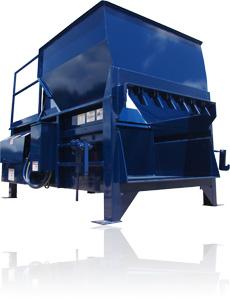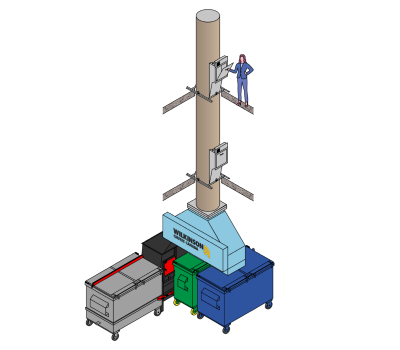Checking Out the Crucial Duty of Waste Devices in Modern Recycling Processes and Sustainable Waste Disposal Practices
The essential function of waste tools in modern-day recycling procedures emphasizes its value in achieving sustainable garbage disposal techniques. Advanced systems, such as automated arranging modern technologies and compactors, not just enhance performance but also play a pivotal function in minimizing contamination prices and boosting material healing. As the demand for more lasting solutions expands, it is important to check out exactly how these innovations adjust to evolving obstacles within waste administration. What innovative advancements are on the horizon that could better transform these processes?
Relevance of Waste Equipment
Why is waste devices critical in the reusing procedure? By facilitating the separation of materials, waste equipment decreases contamination, which is vital in ensuring top notch recyclables that can be reintroduced into making cycles.
Additionally, waste tools improves operational effectiveness and safety and security within recycling facilities. Advanced equipment, such as shredders and balers, allows for the rapid handling of big quantities of waste, minimizing labor costs and handling time. In addition, using specific equipment reduces the danger of injury amongst workers by automating hazardous tasks.
Moreover, the environmental impact of recycling is magnified by reliable waste devices. By maximizing the recycling procedure, centers can considerably reduce the quantity of waste sent to garbage dumps, consequently adding to sustainability initiatives. Finally, waste tools is not merely an ancillary component of reusing; it is a fundamental facet that drives effectiveness, safety and security, and environmental stewardship in modern waste monitoring methods.
Types of Waste Devices
The effectiveness of reusing procedures is closely connected to the specific sorts of waste equipment used in the process. baler rental. Numerous classifications of tools are important to the collection, sorting, handling, and transportation of recyclable products
First of all, collection tools, such as waste collection trucks and bins, is crucial for gathering recyclables from numerous resources, including property, business, and industrial places. As soon as collected, arranging tools, including conveyor belts, shredders, and magnetic separators, plays a vital role in identifying various product types, ensuring that impurities are removed prior to processing.
Processing tools, such as balers and compactors, even more prepares products for recycling by compressing and packaging them into convenient dimensions. This not only optimizes room yet also boosts transport efficiency. Additionally, specialized equipment like granulators and extruders is used for changing materials right into reusable types, specifically in plastic recycling.

Function in Recycling Procedures
In recycling procedures, the function of waste devices is critical in ensuring performance and efficiency at every stage. This tools incorporates an array of equipment made to take care of, process, and kind materials that are to be recycled. The first phase entails collection and transportation, where compactors and balers play a vital duty in enhancing the quantity of materials for transit, therefore lowering operational prices.
When at the reusing facility, shredders and crushers enter play, damaging down materials right into manageable sizes suitable for additional handling. These equipments contribute to enhancing the area of recyclables, promoting extra efficient material recovery. Sorting systems, geared up with innovative innovations such as conveyor belts and optical sensors, make certain that products are accurately separated by type, thus taking full advantage of the high quality of the recycled end item.
Furthermore, specific devices for processing certain products-- such as glass, plastics, and steels-- makes certain that each type is handled in the most efficient fashion. Generally, the assimilation of innovative waste equipment right into the reusing procedure not only enhances operations but also dramatically contributes to the overall recuperation rates of valuable products, emphasizing its important role in contemporary recycling efforts.
Influence On Lasting Practices
Through the effective procedure of waste equipment, reusing this link processes significantly boost sustainable techniques across numerous markets. This effect is understood through increased product recovery rates, which lower the demand for virgin resources. By simplifying sorting and processing functions, advanced waste devices minimizes contamination in recyclable materials, therefore enhancing the high quality of recycled output. The reduction of waste sent out to garbage dumps is an additional vital advantage, as it decreases environmental destruction and mitigates greenhouse gas discharges related to disintegration.

Furthermore, the integration of wise modern technologies in waste administration systems permits for real-time information monitoring and analysis, leading to even more enlightened decision-making and functional effectiveness. As markets progressively focus on sustainability, the function of waste devices comes to be paramount in shaping techniques that straighten with ecological stewardship and governing conformity. Inevitably, the harmony in between waste tools and reusing procedures plays an important duty beforehand broader sustainability goals across communities and sectors alike.
Future Trends in Waste Management
Arising trends in waste monitoring are poised to reshape the landscape of recycling and resource recovery considerably. Smart waste containers outfitted with sensing units can check waste degrees in real-time, optimizing collection paths and minimizing functional costs.
Furthermore, the circular economic climate design is obtaining grip, promoting the concept of reusing products instead of throwing away official source them. This pattern motivates companies to develop products with end-of-life considerations in mind, driving the demand for cutting-edge waste administration services.
Furthermore, public awareness and engagement in sustainability techniques get on the rise, leading to raised engagement in recycling programs. Government plans are likewise progressing, with stricter regulations on garbage disposal and rewards for sustainable practices.
As these fads merge, they produce a more reliable, lasting waste administration system that not only lowers ecological effect but additionally promotes economic growth through resource recovery and innovation in waste tools. The future of waste monitoring looks encouraging, driven by modern technology and a dedication to sustainability.
Final Thought
In verdict, waste tools plays a pivotal function in improving the performance and effectiveness of contemporary recycling procedures. As waste monitoring proceeds to evolve, the importance of cutting-edge waste devices look at this website will certainly stay extremely important in attaining sustainability objectives and addressing the challenges of resource depletion.